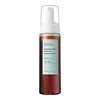What's inside
What's inside
 Key Ingredients
Key Ingredients

No key ingredients
 Benefits
Benefits

 Concerns
Concerns

 Ingredients Side-by-side
Ingredients Side-by-side

Water
Skin ConditioningCoco-Betaine
CleansingGlycerin
HumectantSodium Methyl Cocoyl Taurate
CleansingSodium Cocoyl Isethionate
CleansingSodium Cocoamphoacetate
CleansingBiosaccharide Gum-1
HumectantAloe Barbadensis Leaf Juice
Skin ConditioningLauryl Glucoside
CleansingGlyceryl Oleate
EmollientCoco-Glucoside
CleansingSodium Lauryl Glucose Carboxylate
CleansingSodium Cocoyl Glutamate
CleansingPropanediol
SolventPaeonia Suffruticosa Root Extract
Skin ProtectingCitric Acid
BufferingCentella Asiatica Extract
CleansingHydroxyacetophenone
AntioxidantPanthenol
Skin ConditioningAllantoin
Skin ConditioningDisodium EDTA
Dipotassium Glycyrrhizate
HumectantPhenoxyethanol
PreservativeMoringa Oleifera Seed Oil
EmollientSodium Hyaluronate
Humectant1,2-Hexanediol
Skin ConditioningPotassium Sorbate
PreservativeSodium Benzoate
MaskingHydrogenated Palm Glycerides Citrate
EmollientTocopherol
AntioxidantAscorbyl Palmitate
AntioxidantLecithin
EmollientParfum
MaskingWater, Coco-Betaine, Glycerin, Sodium Methyl Cocoyl Taurate, Sodium Cocoyl Isethionate, Sodium Cocoamphoacetate, Biosaccharide Gum-1, Aloe Barbadensis Leaf Juice, Lauryl Glucoside, Glyceryl Oleate, Coco-Glucoside, Sodium Lauryl Glucose Carboxylate, Sodium Cocoyl Glutamate, Propanediol, Paeonia Suffruticosa Root Extract, Citric Acid, Centella Asiatica Extract, Hydroxyacetophenone, Panthenol, Allantoin, Disodium EDTA, Dipotassium Glycyrrhizate, Phenoxyethanol, Moringa Oleifera Seed Oil, Sodium Hyaluronate, 1,2-Hexanediol, Potassium Sorbate, Sodium Benzoate, Hydrogenated Palm Glycerides Citrate, Tocopherol, Ascorbyl Palmitate, Lecithin, Parfum
Ingredients Explained
These ingredients are found in both products.
Ingredients higher up in an ingredient list are typically present in a larger amount.
Citric Acid is an alpha hydroxy acid (AHA) naturally found in citrus fruits like oranges, lemons, and limes.
Like other AHAs, citric acid can exfoliate skin by breaking down the bonds that hold dead skin cells together. This helps reveal smoother and brighter skin underneath.
However, this exfoliating effect only happens at high concentrations (20%) which can be hard to find in cosmetic products.
Due to this, citric acid is usually included in small amounts as a pH adjuster. This helps keep products slightly more acidic and compatible with skin's natural pH.
In skincare formulas, citric acid can:
While it can provide some skin benefits, research shows lactic acid and glycolic acid are generally more effective and less irritating exfoliants.
Most citric acid used in skincare today is made by fermenting sugars (usually from molasses). This synthetic version is identical to the natural citrus form but easier to stabilize and use in formulations.
Read more about some other popular AHA's here:
Learn more about Citric AcidDisodium EDTA plays a role in making products more stable by aiding other preservatives.
It is a chelating agent, meaning it neutralizes metal ions that may be found in a product.
Disodium EDTA is a salt of edetic acid and is found to be safe in cosmetic ingredients.
Learn more about Disodium EDTAWater. It's the most common cosmetic ingredient of all. You'll usually see it at the top of ingredient lists, meaning that it makes up the largest part of the product.
So why is it so popular? Water most often acts as a solvent - this means that it helps dissolve other ingredients into the formulation.
You'll also recognize water as that liquid we all need to stay alive. If you see this, drink a glass of water. Stay hydrated!
Learn more about Water